|
Growing Christmas
trees is a full-time year round activity for
the trees, a little less so for the tree
farmers. Plantation maintenance is an
ongoing effort, including removing woody
invasives (a constant challenge for us
because we almost never apply
pesticides), culling diseased or oversized
trees, and mowing (which we try to minimize
but still takes time). Work on the trees
themselves, however, tends to fall into
three main periods during the year.
Planting
Planting is an
April activity, a good time to get outside
and and sink hands into soil after a winter
of holding books and coffee cups (yeah
right). We typically plant 2-3 year old
seedlings, about 10-12 inches tall. One
person uses a planting bar or a small
gas-powered auger to open a hole, then
another person inserts the seedling and
fills up the hole. Because we don't spray
herbicides we have a fair amount of
competition from grasses, wildflowers, and
weeds. We lose many seedlings but consider
that a fair trade-off for a better price and
a plantation teeming with plant and animal
diversity.
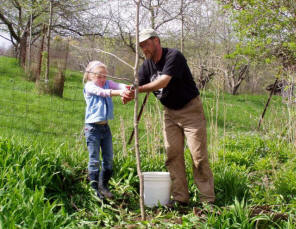
No, this isn't a Christmas tree we're
planting, but it's is the best photo of
planting a tree that I have on
hand!
Shearing
Shearing is
what we call the annual shaping of the trees
into the familiar cone shape of a Christmas
tree. Some farms, especially the larger
farms, use big tractor-mounted machines for
this, but we prefer the flexibility of the
traditional long (16-inch) knives. It is
hard work at a hot time of year, but also
rewarding to see the transformation. Because
the pines grow only during the spring and
early summer and then "set buds", they need
to be sheared during the second half of
June. The spruce and fir can be sheared
pretty much anytime during the summer or
early fall.
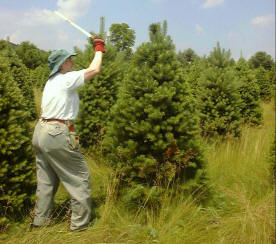
To the right, Pat is shearing.
Below, a double row of (mostly) unsheared
trees on the left, and the same view after
shearing in the right.
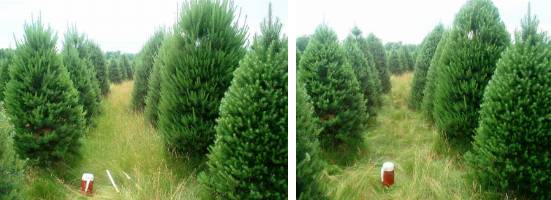
Harvest
Shearing is
hard, hot, sweaty work, but harvest is
probably the most labor-intensive time of
year for us. Most large tree farms (and many
smaller ones) begin harvesting weeks ahead
(sometimes a month or more) of delivery. We
believe this has contributed to the
reputation of live trees as fire hazards,
and the disenchantment of many homeowners
after putting up with dry, often
spray-painted trees with no aroma that drop
their needles on the way IN to the house! We
start cutting our trees no more than five
days before delivery (and often cut just 2-3
days ahead) so that every tree should be
fresh and capable of remaining so throughout
the holiday season.
Tree harvest
isn't just cutting trees and throwing them
into a trailer:
-
The cutting itself
is done with a chainsaw, and on our farm
often entails "high-stumping", because
the heavy competition of grasses,
wildflowers, and weeds often hurts the
lower branches. We typically cut the
tree near the ground, then remove the
branches from the lower 1-2 feet. Then
we cut off part of the stump and use it
for firewood. Finally, we have to
collect and dispose of all those lower
branches.
-
Once cut, the
trees are pulled by hand to
working lanes, then placed (and held) on
a tree shaker attached to a small
tractor. Shaking is necessary,
especially for the pines, to remove dead
needles from previous years that can
build up over time. We rigged the shaker up from an
old sickle mower, and boy does it shake!
Shaking is the least pleasant part of
harvest for the person lifting and
holding the trees on the shaker, getting
a face full of tree dust and needles
each time.
-
After shaking, all
the trees are passed through a netting
baler. The baling makes them much easier
to handle and transport, and it also
maintains freshness by reducing the
transpiration of cut trees.
-
Finally the trees
are loaded onto a trailer - not too
difficult for the lower levels but quite
a challenge to top it off, as shown in
the picture.
-
But that's not the
end of it - we still need to deliver the
trees. Because we believe in local and
regional economies and ecologies, we
deliver our trees no more than a 3-hour
drive from the farm.
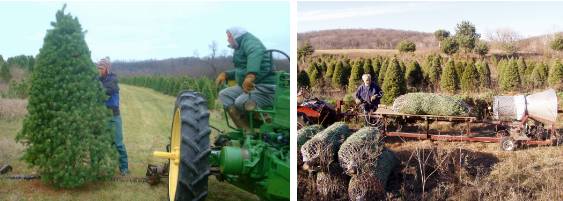
Shaking trees (above left), baling trees
(above right), and
a
successful 100-tree load (the best we can
do)
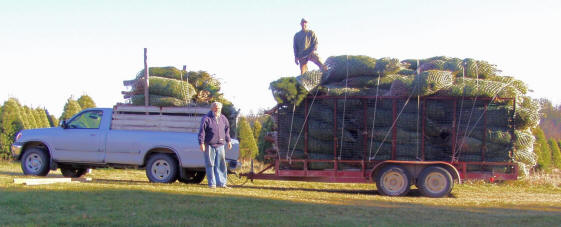
|

